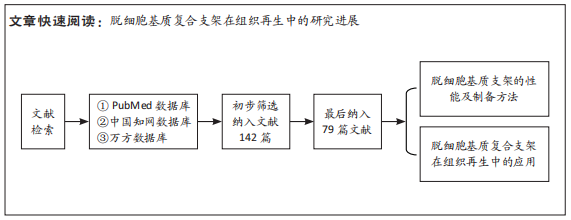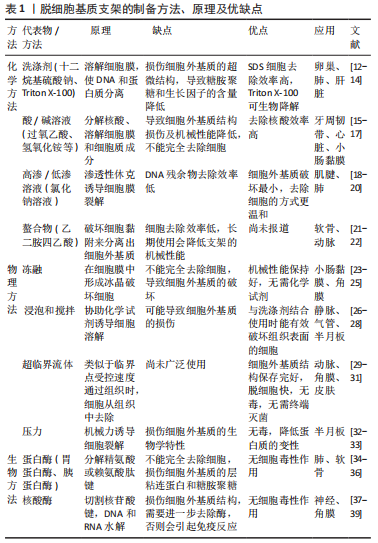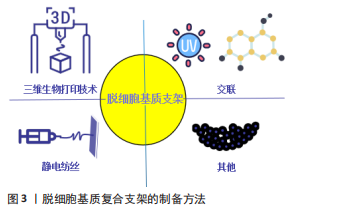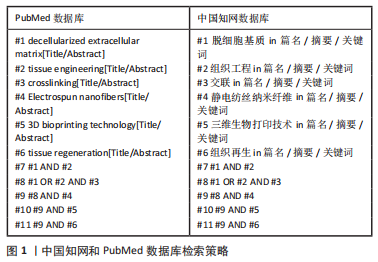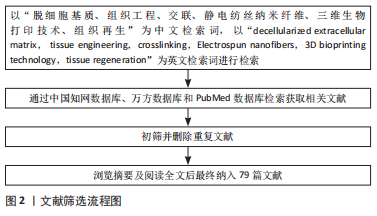[1] CHOUDHURY D, YEE M, SHENG ZLJ, et al. Decellularization systems and devices: State-of-the-art. Acta Biomater. 2020;115:51-59.
[2] PARVEEN S, SINGH SP, PANICKER MM, et al. Amniotic membrane as novel scaffold for human iPSC-derived cardiomyogenesis. In Vitro Cell Dev Biol Anim. 2019;55(4):272-284.
[3] TAYLOR DA, SAMPAIO LC, FERDOUS Z, et al. Decellularized matrices in regenerative medicine. Acta Biomater. 2018;74:74-89.
[4] LIU F, ZHOU H, DU W, et al. Hair follicle stem cells combined with human allogeneic acellular amniotic membrane for repair of full thickness skin defects in nude mice. J Tissue Eng Regen Med. 2020;14(5):723-735.
[5] OHATA K, OTT HC. Human-scale lung regeneration based on decellularized matrix scaffolds as a biologic platform. Surg Today. 2020;50(7):633-643.
[6] AKBAY E, ONUR MA. Investigation of survival and migration potential of differentiated cardiomyocytes transplanted with decellularized heart scaffold. J Biomed Mater Res A. 2019;107(3):561-570.
[7] SASSI L, AJAYI O, CAMPINOTI S, et al. A Perfusion Bioreactor for Longitudinal Monitoring of Bioengineered Liver Constructs. Nanomaterials (Basel). 2021;11(2): 275.
[8] WANG F, LIU X, YU Y, et al. Decellularized kidney scaffold alters the healing response in chronic renal failure. J Biomed Mater Res A. 2021;109(11):2101-2110.
[9] DA LC, HUANG YZ, XIE HQ, et al. Membranous Extracellular Matrix-Based Scaffolds for Skin Wound Healing. Pharmaceutics. 2021;13(11):1796.
[10] DENNER J, TÖNJES RR. Infection barriers to successful xenotransplantation focusing on porcine endogenous retroviruses. Clin Microbiol Rev. 2012;25(2):318-343.
[11] ZHANG Q, HU Y, LONG X, et al. Preparation and Application of Decellularized ECM-Based Biological Scaffolds for Articular Cartilage Repair: A Review. Front Bioeng Biotechnol. 2022;10:908082.
[12] ALSHAIKH AB, PADMA AM, DEHLIN M. Decellularization of the mouse ovary: comparison of different scaffold generation protocols for future ovarian bioengineering. J Ovarian Res. 2019;12(1):58.
[13] SONG YH, MAYNES MA, HLAVAC N, et al. Development of novel apoptosis-assisted lung tissue decellularization methods. Biomater Sci. 2021;9(9):3485-3498.
[14] WILLEMSE J, VERSTEGEN MMA, VERMEULEN A, et al. Fast, robust and effective decellularization of whole human livers using mild detergents and pressure controlled perfusion. Mater Sci Eng C Mater Biol Appl. 2020;108:110200.
[15] FARAG A, HASHIMI SM, VAQUETTE C, et al. Assessment of static and perfusion methods for decellularization of PCL membrane-supported periodontal ligament cell sheet constructs. Arch Oral Biol. 2018;88:67-76.
[16] WOLLMANN L, SUSS P, MENDONÇA J, et al. Characterization of Decellularized Human Pericardium for Tissue Engineering and Regenerative Medicine Applications. Arq Bras Cardiol. 2019;113(1):11-17.
[17] SYED O, WALTERS NJ, DAY RM, et al. Evaluation of decellularization protocols for production of tubular small intestine submucosa scaffolds for use in oesophageal tissue engineering. Acta Biomater. 2014;10(12):5043-5054.
[18] AEBERHARD PA, GROGNUZ A, PENEVEYRE C, et al. Efficient decellularization of equine tendon with preserved biomechanical properties and cytocompatibility for human tendon surgery indications. Artif Organs. 2020;44(4):E161-E171.
[19] ROTH SP, BREHM W, GROß C, et al. Transforming Growth Factor Beta 3-Loaded Decellularized Equine Tendon Matrix for Orthopedic Tissue Engineering. Int J Mol Sci. 2019;20(21):5474.
[20] ROSMARK O, ÅHRMAN E, MÜLLER C, et al. Quantifying extracellular matrix turnover in human lung scaffold cultures. Sci Rep. 2018;8(1):5409.
[21] PORZIONATO A, STOCCO E, BARBON S, et al. Tissue-Engineered Grafts from Human Decellularized Extracellular Matrices: A Systematic Review and Future Perspectives. Int J Mol Sci. 2018;19(12):4117.
[22] CHENG J, WANG C, GU Y. Combination of freeze-thaw with detergents: A promising approach to the decellularization of porcine carotid arteries. Biomed Mater Eng. 2019;30(2):191-205.
[23] RABBANI M, ZAKIAN N, ALIMORADI N. Contribution of Physical Methods in Decellularization of Animal Tissues. J Med Signals Sens. 2021;11(1):1-11.
[24] FERDOWSI KHOSROSHAHI A, SOLEIMANI RAD J, KHEIRJOU R, et al. Adipose tissue-derived stem cells upon decellularized ovine small intestine submucosa for tissue regeneration: An optimization and comparison method. J Cell Physiol. 2020;235(2):1556-1567.
[25] FERNÁNDEZ-PÉREZ J, AHEARNE M. The impact of decellularization methods on extracellular matrix derived hydrogels. Sci Rep. 2019;9(1):14933.
[26] SIMSA R, VILA XM, SALZER E, et al. Effect of fluid dynamics on decellularization efficacy and mechanical properties of blood vessels. PLoS One. 2019;14(8):e0220743.
[27] GUIMARAES AB, CORREIA AT, ALVES BP, et al. Evaluation of a Physical-Chemical Protocol for Porcine Tracheal Decellularization. Transplant Proc. 2019;51(5):1611-1613.
[28] YUSOF F, SHA’BAN M, AZHIM A. Development of decellularized meniscus using closed sonication treatment system: potential scaffolds for orthopedics tissue engineering applications. Int J Nanomedicine. 2019;14:5491-5502.
[29] GULER S, ASLAN B, HOSSEINIAN P, et al. Supercritical Carbon Dioxide-Assisted Decellularization of Aorta and Cornea. Tissue Eng Part C Methods. 2017;23(9): 540-547.
[30] CHOU PR, LIN YN, WU SH, et al. Supercritical Carbon Dioxide-decellularized Porcine Acellular Dermal Matrix combined with Autologous Adipose-derived Stem Cells: Its Role in Accelerated Diabetic Wound Healing. Int J Med Sci. 2020; 17(3):354-367.
[31] GIL-RAMÍREZ A, ROSMARK O, SPÉGEL P, et al. Pressurized carbon dioxide as a potential tool for decellularization of pulmonary arteries for transplant purposes. Sci Rep. 2020;10(1):4031.
[32] WATANABE N, MIZUNO M, MATSUDA J, et al. Comparison of High-Hydrostatic-Pressure Decellularized Versus Freeze-Thawed Porcine Menisci. J Orthop Res. 2019;37(11):2466-2475.
[33] GILPIN A, YANG Y. Decellularization Strategies for Regenerative Medicine: From Processing Techniques to Applications. Biomed Res Int. 2017;2017:9831534.
[34] POULIOT RA, YOUNG BM, LINK PA, et al. Porcine Lung-Derived Extracellular Matrix Hydrogel Properties Are Dependent on Pepsin Digestion Time. Tissue Eng Part C Methods. 2020;26(6):332-346.
[35] LI J, CAI Z, CHENG J, et al. Characterization of a heparinized decellularized scaffold and its effects on mechanical and structural properties. J Biomater Sci Polym Ed. 2020;31(8):999-1023.
[36] RAHMAN S, GRIFFIN M, NAIK A, et al. Optimising the decellularization of human elastic cartilage with trypsin for future use in ear reconstruction. Sci Rep. 2018; 8(1):3097.
[37] MCCRARY MW, VAUGHN NE, HLAVAC N, et al. Novel Sodium Deoxycholate-Based Chemical Decellularization Method for Peripheral Nerve. Tissue Eng Part C Methods. 2020;26(1):23-36.
[38] DONG M, ZHAO L, WANG F, et al. Rapid porcine corneal decellularization through the use of sodium N-lauroyl glutamate and supernuclease. J Tissue Eng. 2019;10:2041731419875876.
[39] PHAN NV, WRIGHT T, RAHMAN MM, et al. In Vitro Biocompatibility of Decellularized Cultured Plant Cell-Derived Matrices. ACS Biomater Sci Eng. 2020;6(2):822-832.
[40] HUSSEY GS, DZIKI JL, BADYLAK SF. Extracellular matrix-based materials for regenerative medicine. Nat Rev Mater. 2018;3(7):159-173.
[41] GAO M, WANG Y, HE Y, et al. Comparative evaluation of decellularized porcine liver matrices crosslinked with different chemical and natural crosslinking agents. Xenotransplantation. 2019;26(1):e12470.
[42] 刘俊,张晓膺. 纳米APS外膜肝素化内膜小口径组织工程血管的实验研究[J].上海交通大学学报(医学版),2017,37(3):337-343.
[43] 杨振,李浩,付力伟,等.3D生物打印负载转化生长因子β3的软骨复合支架[J].中国组织工程研究,2021,25(34):5445-5452.
[44] ZHANG X, CHEN X, HONG H, et al. Decellularized extracellular matrix scaffolds: Recent trends and emerging strategies in tissue engineering. Bioact Mater. 2021; 10:15-31.
[45] ZHANG XZ, JIANG YL, HU JG, et al. Procyanidins-crosslinked small intestine submucosa: A bladder patch promotes smooth muscle regeneration and bladder function restoration in a rabbit model. Bioact Mater. 2020;6(6):1827-1838.
[46] ARRIZABALAGA JH, NOLLERT MU. Human Amniotic Membrane: A Versatile Scaffold for Tissue Engineering. ACS Biomater Sci Eng. 2018;4(7):2226-2236.
[47] DAVIDENKO N, BAX DV, SCHUSTER CF, et al. Optimisation of UV irradiation as a binding site conserving method for crosslinking collagen-based scaffolds. J Mater Sci Mater Med. 2016;27(1):14.
[48] YAO Q, ZHENG YW, LAN QH, et al. Recent development and biomedical applications of decellularized extracellular matrix biomaterials. Mater Sci Eng C Mater Biol Appl. 2019;104:109942.
[49] ARRIZABALAGA JH, NOLLERT MU. Riboflavin-UVA crosslinking of amniotic membranes and its influence on the culture of adipose-derived stem cells. J Mech Behav Biomed Mater. 2020;106:103729.
[50] SCHNEIDER KH, ROHRINGER S, KAPELLER B, et al. Riboflavin-mediated photooxidation to improve the characteristics of decellularized human arterial small diameter vascular grafts. Acta Biomater. 2020;116:246-258.
[51] MA B, WANG X, WU C, et al. Crosslinking strategies for preparation of extracellular matrix-derived cardiovascular scaffolds. Regen Biomater. 2014;1(1):81-89.
[52] WANG Y, BAO J, WU X, et al. Genipin crosslinking reduced the immunogenicity of xenogeneic decellularized porcine whole-liver matrices through regulation of immune cell proliferation and polarization. Sci Rep. 2016;6:24779.
[53] YAO Q, ZHENG YW, LIN HL, et al. Exploiting crosslinked decellularized matrix to achieve uterus regeneration and construction. Artif Cells Nanomed Biotechnol. 2020;48(1):218-229.
[54] 蒋涛,任先军,阴洪,等.京尼平交联大鼠脱细胞脊髓支架的制备及其生物力学特性研究[J]. 中华创伤杂志,2014,30(2):180-184.
[55] LIU W, BI W, SUN Y, et al. Biomimetic organic-inorganic hybrid hydrogel electrospinning periosteum for accelerating bone regeneration. Mater Sci Eng C Mater Biol Appl. 2020;110:110670.
[56] GONG W, LEI D, LI S, et al. Hybrid small-diameter vascular grafts: Anti-expansion effect of electrospun poly ε-caprolactone on heparin-coated decellularized matrices. Biomaterials. 2016;76:359-370.
[57] GHORBANI F, MORADI L, SHADMEHR MB, et al. In-vivo characterization of a 3D hybrid scaffold based on PCL/decellularized aorta for tracheal tissue engineering. Mater Sci Eng C Mater Biol Appl. 2017;81:74-83.
[58] 冉小琳.利用猪冠状动脉脱细胞基质和PLCL/明胶纺丝构建双层小口径人工血管的研究[D].重庆:重庆大学,2018.
[59] MA YH, SHI HJ, WEI QS, et al. Developing a mechanically matched decellularized spinal cord scaffold for the in situ matrix-based neural repair of spinal cord injury. Biomaterials. 2021;279:121192.
[60] GHOLIPOURMALEKABADI M, SAMADIKUCHAKSARAEI A, SEIFALIAN AM, et al. Silk fibroin/amniotic membrane 3D bi-layered artificial skin. Biomed Mater. 2018; 13(3):035003.
[61] PARK W, GAO G, CHO DW. Tissue-Specific Decellularized Extracellular Matrix Bioinks for Musculoskeletal Tissue Regeneration and Modeling Using 3D Bioprinting Technology. Int J Mol Sci. 2021;22(15):7837.
[62] KIM MK, JEONG W, LEE SM, et al. Decellularized extracellular matrix-based bio-ink with enhanced 3D printability and mechanical properties. Biofabrication. 2020;12(2):025003.
[63] YU C, MA X, ZHU W, et al.Scanningless and continuous 3D bioprinting of human tissues with decellularized extracellular matrix. Biomaterials. 2019;194:1-13.
[64] JANG J, KIM TG, KIM BS, et al. Tailoring mechanical properties of decellularized extracellular matrix bioink by vitamin B2-induced photo-crosslinking. Acta Biomater. 2016;33:88-95.
[65] VISSCHER DO, LEE H, VAN ZUIJLEN PPM, et al. A photo-crosslinkable cartilage-derived extracellular matrix bioink for auricular cartilage tissue engineering. Acta Biomater. 2021;121:193-203.
[66] CHOI YJ, JUN YJ, KIM DY, et al. A 3D cell printed muscle construct with tissue-derived bioink for the treatment of volumetric muscle loss. Biomaterials. 2019; 206:160-169.
[67] ZHANG X, LIU Y, LUO C, et al. Crosslinker-free silk/decellularized extracellular matrix porous bioink for 3D bioprinting-based cartilage tissue engineering. Mater Sci Eng C Mater Biol Appl. 2021;118:111388.
[68] KHATI V, RAMACHANDRAIAH H, PATI F, et al. 3D Bioprinting of Multi-Material Decellularized Liver Matrix Hydrogel at Physiological Temperatures. Biosensors (Basel). 2022;12(7):521.
[69] SALEH TM, AHMED EA, YU L, et al. Incorporation of nanoparticles into transplantable decellularized matrices: Applications and challenges. Int J Artif Organs. 2018;41(8):421-430.
[70] SALEH T, AHMED E, YU L, et al. Characterization of silver nanoparticle-modified decellularized rat esophagus for esophageal tissue engineering: Structural properties and biocompatibility. J Biosci Bioeng. 2019;128(5):613-621.
[71] PESARAKLOU A, MAHDAVI-SHAHRI N, HASSANZADEH H, et al.Use of cerium oxide nanoparticles: a good candidate to improve skin tissue engineering. Biomed Mater. 2019;14(3):035008.
[72] KYLUIK-PRICE DL, SCOTT MD. Effects of methoxypoly (Ethylene glycol) mediated immunocamouflage on leukocyte surface marker detection, cell conjugation, activation and alloproliferation. Biomaterials. 2016;74:167-177.
[73] LE Y, SCOTT MD. Immunocamouflage: the biophysical basis of immunoprotection by grafted methoxypoly(ethylene glycol) (mPEG). Acta Biomater. 2010;6(7):2631-2641.
[74] LIU K, HE Y, YAO Y, et al. Methoxy polyethylene glycol modification promotes adipogenesis by inducing the production of regulatory T cells in xenogeneic acellular adipose matrix. Mater Today Bio. 2021;12:100161.
[75] SU Z, MA H, WU Z, et al. Enhancement of skin wound healing with decellularized scaffolds loaded with hyaluronic acid and epidermal growth factor. Mater Sci Eng C Mater Biol Appl. 2014;44:440-448.
[76] QIU S, RAO Z, HE F, et al. Decellularized nerve matrix hydrogel and glial-derived neurotrophic factor modifications assisted nerve repair with decellularized nerve matrix scaffolds. J Tissue Eng Regen Med. 2020;14(7):931-943.
[77] VELNAR T, BAILEY T, SMRKOLJ V. The wound healing process: an overview of the cellular and molecular mechanisms. J Int Med Res. 2009;37(5):1528-1542.
[78] SUTHERLAND AJ, CONVERSE GL, HOPKINS RA, et al. The bioactivity of cartilage extracellular matrix in articular cartilage regeneration. Adv Healthc Mater. 2015;4(1):29-39.
[79] NICA C, LIN Z, SCULEAN A, et al.Adsorption and Release of Growth Factors from Four Different Porcine-Derived Collagen Matrices. Materials (Basel). 2020;13(11):2635. |
